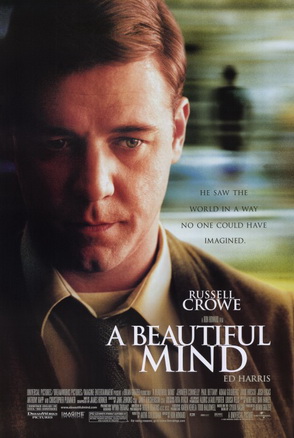A Beautiful Mind

There is really no feeling like walking into a classroom and seeing “Movie” scheduled for the next three days. Relief washes over you as you contemplate the amount of homework you will be able to sneakily complete under the black cover of a dark classroom. As this was the case in my Advanced Psychology class, I was prepared to be bored completely by a movie about an old mathematician, and to complete my calculus as I paid no attention to it. However, I was completely taken aback by A Beautiful Mind, and in the best way possible.
A Beautiful Mind centers around the life of John Nash, a 1994 Nobel laureate whose work inspired many breakthroughs in the economic and mathematic fields. It begins as Nash enters Princeton on a massive scholarship, ready to study mathematics and hoping to publish original papers based on his own thoughts. As he struggles to come up with an idea, we meet his classmates and future colleagues, along with those who will come to influence his life in many sorts of ways. From his time in the classroom on, we travel through life with John as he is summoned to break codes for the government, takes on a teaching job, and deals with many obstacles along his journey to becoming a well-known scientific mind.
One might be thinking, why would an Advanced Psychology class be watching a film about a mathematician? Well, John Nash suffered from schizophrenia, a mental disorder we had been studying at the time which is known best for the hallucinations and delusions that accompany it. Nash suffered from full-blown schizophrenia from the time he entered grad school in 1948 (at age 19) until he was first diagnosed in 1959. His strange personality masked his symptoms at first, since many thought his antics were just part of his bizarre daily routine, not in response to his disorder. One of many things the movie does a spectacular job of is portraying these symptoms as something real, and getting inside the mind of a schizophrenic to see what it would truly be like to deal with the disorder.
Another one of the movie’s strengths is its cast. It is led by Russell Crowe as John Nash, who does an amazing job diving into the character to realistically become someone who serves as such an icon to the schizophrenic and scientific communities alike. Crowe captures beautifully the physical symptoms of the disorder that many overlook, along with the many idiosyncrasies of Nash, and won a Golden Globe for his work. Equally as great is Jennifer Connelly as John’s wife, Alicia de-Larde Nash. Her Academy Award winning performance shows not only the spunk of Alicia, but the toll that schizophrenia can take on others, and the chemistry between Connelly and Crowe was undeniably great.
While the movie is centered around the real life of John Nash, the producers made very clear that the movie was not meant to be a documentary, so not every detail mirrors his life; regardless, the film does an excellent job of replicating his high (and low) points while providing entertainment for the audience and bringing awareness to the troubles of dealing with schizophrenia. In addition to its numerous other awards and other three Oscars, the Best Picture winner at the Oscars gained a huge following and acclaim from seasoned movie-goers and novices alike.
The movie is one with plot twists, action, romance, and mystery, something you would not expect from a film about the life of a mathematician. It draws you in, keeps you intrigued, and shows you the world from the point of view of a truly beautiful mind. From both a psychology standpoint and one of simple pleasure, A Beautiful Mind is a must-see.

Caroline is in her senior year and second year on staff, and is one of three Editors in Chief. In her junior year, Caroline was the Financial Advisor and...

























































































